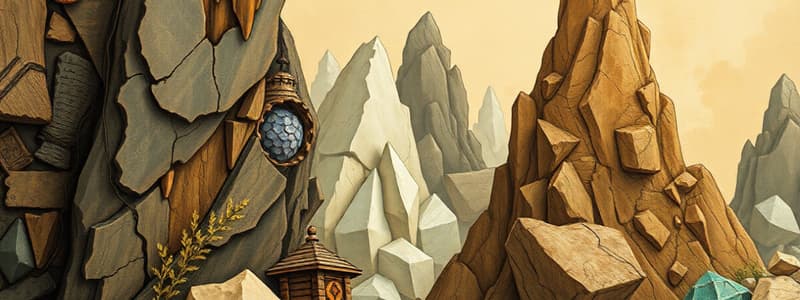Podcast
Questions and Answers
What is a defining characteristic of minerals?
What is a defining characteristic of minerals?
- Homogeneous substance with a defined chemical composition (correct)
- Organic origin
- Only formed under high pressure
- Amorphous structure
Which of the following best describes magmatic processes?
Which of the following best describes magmatic processes?
- Requires stable conditions without temperature changes
- Leads only to the formation of sedimentary rocks
- Occurs at atmospheric pressure and temperature with no melting involved
- Involves solidification of magma into igneous rocks (correct)
What is the primary result of metamorphic processes?
What is the primary result of metamorphic processes?
- Erosion of mineral content
- Recrystallization of existing rocks (correct)
- Formation of igneous rocks
- Creation of sedimentary layers
What distinguishes sedimentary rocks from other types of rocks?
What distinguishes sedimentary rocks from other types of rocks?
What is magma primarily composed of?
What is magma primarily composed of?
Flashcards are hidden until you start studying
Study Notes
Minerals
- Minerals are solid, naturally occurring substances with a defined and variable chemical composition and inorganic crystalline structure.
- Some common minerals and their chemical compositions:
- Quartz: SiO₂
- Pyrite: FeS₂
- Calcite: CaCO₃
- Fluorite: CaF₂
Rocks
- Rocks are solid aggregates made up of minerals with common origin, stable under pressure and temperature.
- The environment where rocks are formed is called a petrogenetic environment.
- Petrogenetic environments have specific temperature, pressure, and chemical compositions that allow for the formation of minerals and rocks.
Types of Rocks
- Magmatic Rocks: Form from the solidification of magma, a molten mass of variable silicate content with liquid, solid, and gaseous parts.
- Metamorphic Rocks: Form from the transformation of existing rocks due to recrystallization at high temperatures.
- Sedimentary Rocks: Form from the accumulation and lithification of sediments, usually at river mouths or at the foothills of mountains.
Geodynamic Internal Processes: Magmatism and Metamorphism
- Magma: Molten rock found beneath the Earth's surface.
- Lava: Molten rock that has reached the Earth's surface.
- Igneous Rocks: Formed from the cooling and solidification of magma or lava.
- The process of magmatism involves the generation, movement, and solidification of magma.
- Metamorphism involves the transformation of existing rocks due to changes in temperature, pressure, and chemical environment.
Studying That Suits You
Use AI to generate personalized quizzes and flashcards to suit your learning preferences.




